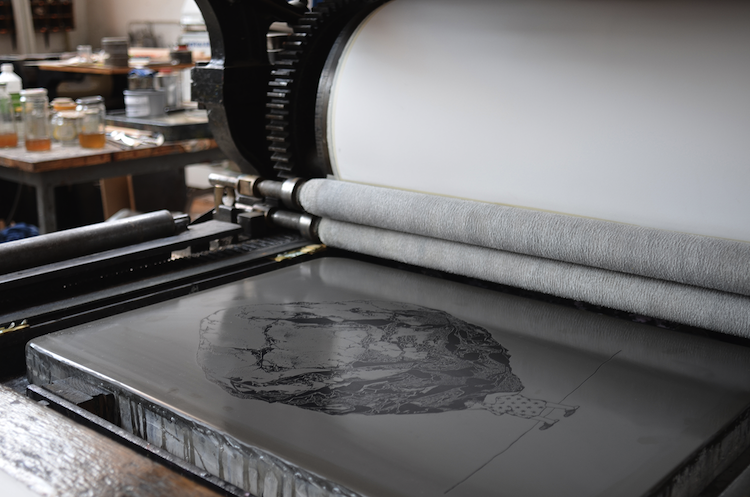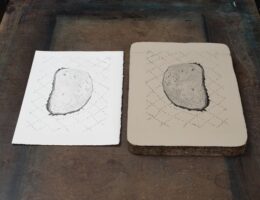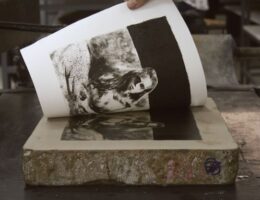IRAN ART EXHIBITION: WHAT’S THE STORY BEHIND OF LITHOGRAPHY?
Lithography is a printing process that uses a flat stone or metal plate on which the image areas are worked using a greasy substance so that the ink will adhere to them by, while the non-image areas are made ink-repellent
A printing process based on the fact that grease and water don’t mix. The image is applied to a grained surface (traditionally stone but now usually aluminium) using a greasy medium: such as a special greasy ink – called tusche, crayon, pencils, lacquer, or synthetic materials. Photochemical or transfer processes can also be used. A solution of gum arabic and nitric acid is then applied over the surface, producing water-receptive non-printing areas and grease-receptive image areas. The printing surface is kept wet, so that a roller charged with oil-based ink can be rolled over the surface, and ink will only stick to the grease-receptive image area. Paper is then placed against the surface and the plate is run through a press.
Lithography was invented in the late eighteenth century, initially using Bavarian limestone as the printing surface. Its invention made it possible to print a much wider range of marks and areas of tone than possible with earlier printmaking relief or intaglio methods. It also made colour printing easier: areas of different colours can be applied to separate stones and overprinted onto the same sheet.
Offset lithography involves printing the image onto an intermediate surface before the final sheet. The process is ‘offset’ because the plate does not come in direct contact with the paper, which preserves the quality of the plate. With offset lithography, the image is reversed twice, and appears on the final sheet the same way round as on the stone or plate.
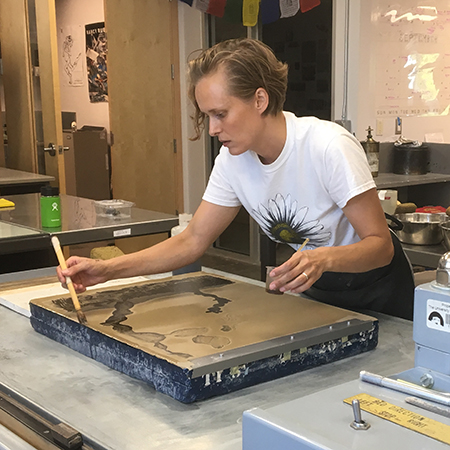
IRAN ART EXHIBITION: lithography, planographic printing process that makes use of the immiscibility of grease and water.
In the lithographic process, ink is applied to a grease-treated image on the flat printing surface; nonimage (blank) areas, which hold moisture, repel the lithographic ink. This inked surface is then printed—either directly on paper, by means of a special press (as in most fine-art printmaking), or onto a rubber cylinder (as in commercial printing).
The process was discovered in 1798 by Alois Senefelder of Munich, who used a porous Bavarian limestone for his plate (hence lithography, from Greek lithos, “stone”). The secret of lithographic printing was closely held until 1818, when Senefelder published Vollständiges Lehrbuch der Steindruckerey (A Complete Course of Lithography).
Fine-art lithography
The earliest—though no longer the only—method of creating lithographs involved the use of a block of porous limestone. The method of preparing such stones for hand printing has remained substantially unchanged since Senefelder’s time. The materials and procedures of the 19th-century lithographer are duplicated in almost every respect by the contemporary hand printer. An image is drawn with tusche (a carbon pigment in liquid form) and litho crayon before the printing surface is fixed, moistened, and inked in preparation for printing. The printing itself is done on a press that exerts a sliding or scraping pressure. Because it undergoes virtually no wear in printing, a single stone can yield an almost unlimited number of copies, although in art printmaking only a specific number of prints are pulled, signed, and numbered before the stone is “canceled” (defaced). Techniques developed in the 20th century varied the process considerably, though many artists continue to prefer the time-honoured method.
Lithography became a popular medium among the artists who worked in France during the mid-1800s; Francisco de Goya (in voluntary exile in France), Théodore Géricault, and Eugène Delacroix were among the first lithographers. Honoré Daumier was far more prolific, however, making about 4,000 designs, ranging from newspaper caricatures to broadsides printed on a single sheet. Daumier was one of the first lithographers to make use of the process called transfer lithography, by which the tusche drawing is made on paper instead of on the lithographic stone. The drawing is then transferred to the stone and printed in the usual way. This method, which is more convenient than working on stone, retains the paper’s texture in the final print. In the second half of the 19th century, Edgar Degas and Édouard Manet worked in lithography, and Odilon Redon made it his principal means of expression.
Colour lithographs, called chromolithographs or oleographs, were developed in the second half of the 19th century. Although popular, they were of generally poor quality. In the hands of Henri de Toulouse-Lautrec, however, colour lithography in the 1890s reached new heights, and his example was enthusiastically followed by Paul Gauguin, Pierre Bonnard, and Édouard Vuillard. The subtle views of the River Thames that the American expatriate artist James McNeill Whistler rendered in the late 19th century in transfer lithography stand in marked contrast to the straightforward and robust lithographs commercially produced in the United States in the mid-19th century by the firm of Currier & Ives.
IRAN ART EXHIBITION: In the 20th century the Norwegian Edvard Munch; the German Expressionists, especially Max Beckmann, Ernst Kirchner, and Käthe Kollwitz; José Clemente Orozco, Diego Rivera, and Rufino Tamayo of Mexico; the Americans George Wesley Bellows, Robert Rauschenberg, and Jasper Johns; the Frenchmen Henri Matisse and Georges Rouault; and, above all, the Spaniard Pablo Picasso imbued the medium with great vitality and power.
Commercial lithography
After about 1825 many firms that utilized the lithographic process were established for producing a variety of commercial work and for distributing popular topical, historical, and religious subjects to a wide audience. The best known of these publishers was Currier & Ives of New York City. The firm’s popular lithographs were printed in black ink and were often hand coloured by an assembly line of women, each of whom applied a separate tint of watercolour.
Some good early work was done in colour lithography (using coloured inks) by Godefroy Englemann in 1837 and Thomas S. Boys in 1839, but the method did not come into wide commercial use until 1860. It then became the most popular method of colour reproduction for the remainder of the 19th century. These commercial prints were made by preparing a separate stone by hand methods for each colour (tint) to be used and printing one colour in register over another. Sometimes as many as 30 stones were employed for a single subject.
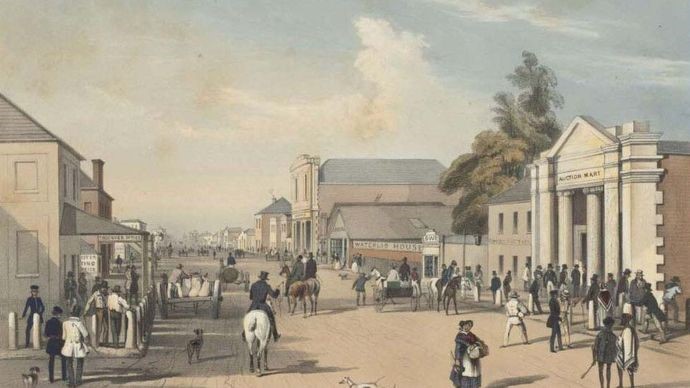
Adelaide, Australia
View of Hindley Street from the corner of King William Street in Adelaide, Australia, lithogaph by J.W. Giles, 1847.
The steam-driven lithographic press was perfected by Hughes & Kimber of England in about 1865. It was introduced into the United States in 1866. These presses utilized automatic rollers to moisten and ink the stone, while the paper was pressed into contact by a revolving cylinder.
In 1853 the method known as offset lithography (or offset printing) was first patented by John Strather of England. The principle was not practically applied until the 1870s, when rubber offset rollers were used on flat-bed presses for printing on metals. In 1860 the phototransfer process was patented, enabling a photographic image on sensitized paper to be inked and transferred to the printing surface. Six years later the first lithographic halftone screen was used in England. Offset methods for printing on paper were developed in the United States shortly after 1900.
In the offset process—by far the most popular method in use—the inked image is first printed on a rubber cylinder, which then offsets, or transfers, the image to paper or other materials. Because of the flexibility of the rubber cylinder, offset lithography can be used to print on tin, wood, cloth, leather, and rough or smooth paper. In the past, offset printing was used mainly to produce printed matter—calendars, greeting cards, booklets, letterheads, books, magazines, newspapers, maps, posters, billboards, stamps, labels on cans, packaging, and other advertising matter—in large quantities. By the turn of the 21st century, however, an increasing number of artists, including Eugene Feldman, Hanne Darboven, Joseph Beuys, Gerhard Richter, Dieter Roth, and Kara Walker, had used the offset process to noncommercial ends.
IRAN ART EXHIBITION: Lithographic printing on a modern rotary offset press can produce high-quality, finely detailed impressions at high speed. It can reproduce any material that can be photographed in the platemaking process. As a result, it accounts for more than 40 percent of all printing, packaging, and publishing carried out; that percentage is more than twice the percentage produced by any other single printing process.
